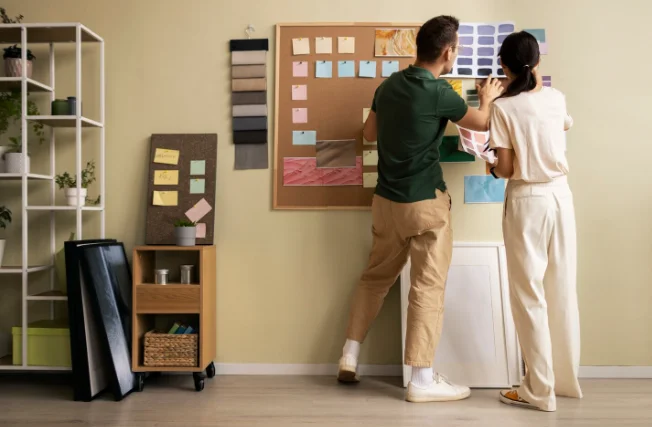Welcome to the ever-changing world of interior design! Once or twice, scrolling through various decoration pages is largely filled with excitement and a bit of agitation. Fashions change, new materials appear, and the trends of yesterday seem outdated today. Here on the Eastside, with that lovely mixture of pristine nature and innovation, homes tend to reflect beauty bestowed upon them by nature.
So, what are we looking at? As we gaze at 2026, the trends lean less toward passing fads and more toward the deeply personal, sustainable, and connected creation of spaces around us. A home that looks nice and feels totally good to be in is worth having. Now, let’s discuss four key design trends that will mold and set the tone for Eastside homes in the next year.
What Comes Into Play: Biophilic Design
For years, we have been hearing about the concept of bringing the outdoors into the house. Biophilic design digs deeper into that thought. It is a philosophy whereby a tangible connection to nature is created within our living environment for stress reduction and multiplicity of well-being factors. As we live in the Pacific Northwest surrounded by some of the most gorgeous scenery, this trend is all about infusing that natural beauty into our homes.
Think bigger than just a few plants sitting about. There is a clear rise in the use of natural materials, such as those of organic origin, in more conspicuous ways. Key elements include:
- Light timber flooring that takes you into a walk in the woods.
- Quartzite countertops carrying ellenic, flowing veins.
- The texture of walls cast in plaster or limewash to provide that extra bit of natural depth.
- Oversized open-windowed views of Mount Cascades or Lake Washington become the masterpiece of a room.
These unfold into all manner of home renovations and cultivation into lifestyles that create expanses flooded with natural light and light flow, joining the interior living room with the garden.
The Smart and Sustainable Sanctuary
Living in the Eastside gives one that edge of being in the center of technology and innovation; therefore, our homes, inevitably, are growing smarter. The 2026 smart home is, however, something more than just convenience; it is about running the home efficiently and well. The emphasis is slowly shifting from novel gadgets to integrated systems that enrich our lives while lessening the impact on the environment.
In other words, it could mean:
- Innovative climate control that senses your activity patterns.
- Lighting that adjusts to natural daylight cycles.
- Appliances that conserve energy while exerting more of their potential.
This goes on with a tech-forward approach to premium materials. Usage scenarios come increasingly into play, giving way to glass countertops made of recycled glass, wood flooring acquired through reclaimed wood, and low-VOC paints that raise indoor air quality. It is a holistic view upon nature of home health, both for the planet and for the ones living therein. It testifies that luxury and responsibility can and should be paired.
From Function to Phenomenon: Spa at Home Experience
One of the most thrilling transitions to observe is the making of highly personalized spaces that promote well-being. We are finally veering away from-a-one-size-fits-all paradigm and instead designing rooms that suit our particular daily rituals. There can be no finer example of this trend than the bathroom. It is no longer just an utilitarian room to rush through in the morning; it is now slowly transforming into a private sanctuary for decompression and care.
The trend is being beautifully exemplified in projects all over town including bathroom remodel Kirkland turning into a personalized retreat from a purely service-oriented space. Imagine walking into a shower with a rainfall head that offers aromatherapy treatments, or slipping into a deep soaking tub in front of a wall of natural stone.
Key features now considered standard include:
- Heated flooring.
- Dimmable lighting.
- An integrated sound system.
Of course, it’s not extravagance for it’s sake; this is really designing a small slice of your house as an actual getaway.
The New Neutrals: Warmth and Character Injection
Traditionally, the modern minimalist aesthetic always counted cool grays and whites as part of its spectrum. Such a palette may feel cold or impersonal while being composed and simple. As time gears up toward 2026, the notion of “neutral” is being given a warm and cozy makeover. New base colors for homes are evolving into richer, cozier hues, which foster feelings of comfort and stability.
Think about these alternatives:
- Creamy, oat-milk tones, not sterile white.
- In place of a cool gray, opt for a good canvas color of warm taupe, or a setting “greige.”
These new neutrals possess depth and character and make a lovely canvas for pairing with natural woods and textures defined by biophilic design. Muted, nature-inspired colors are also now being turned toward as the new neutrals themselves. A dark olive green, a dusty blue, or a warm terracotta works best as a primary color for a room to keep the space tonally grounded while also giving it loads of personality that is never overwhelming. The sentiment here is to make a house feel like being wrapped in warm, welcoming ambience from the very moment one steps inside.
Your Home, Your Haven
In embracing these 2026 trends, one thread goes through all: the home grows evermore intentional. What this means is that increasingly we want our homes to be places that are equally stylish as they are smart and healthy-and that personalize themselves to the needs of the user. Whether that is in tight kinship with nature, through sustainability, or into your very own home spa, the end game is to create a home that truly reflects you.










 /home/u448362301/domains/theexpotab.com/public_html/wp-content/themes/foxiz/templates/popup.php on line 167
/home/u448362301/domains/theexpotab.com/public_html/wp-content/themes/foxiz/templates/popup.php on line 167